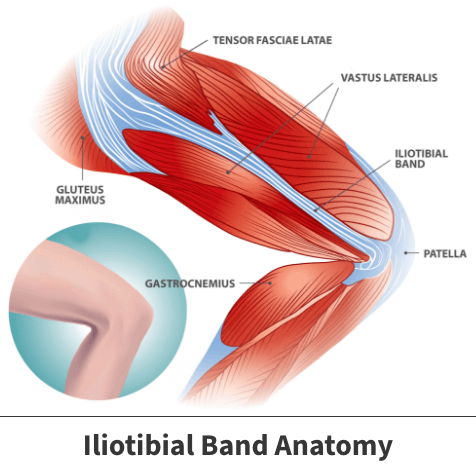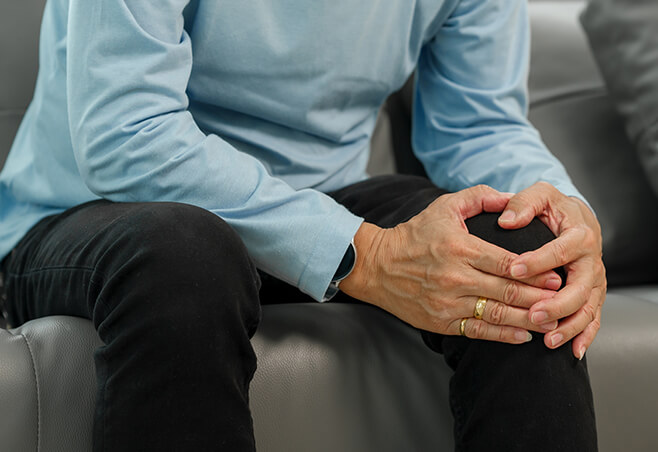IT band syndrome
(ITBS)
If you’ve got a nagging pain on the outer part of your knee, especially if you’re a runner, it could be a symptom of iliotibial band syndrome (ITBS). It’s an injury often caused by activities where you bend your knee repeatedly, like running, cycling, hiking, and walking long distances. ITBS is typically caused by working the IT band too hard or not stretching it out well enough.
Symptoms of ITBS are mainly just pain in the knee, and it is diagnosed with a physical examination. Non-surgical treatments such as physical therapy and rest are the main ways to treat this injury and will usually last only six weeks. After six weeks, you should be ready to return to your regular activities.
Anatomy

Your IT Band is a thick bunch of fibers that runs from the outside of your hips to the outside of your thigh and knee, down to the top of your shinbone. There is a fluid-filled sac in the knee (the bursa) which helps the IT Band glide smoothly over your knee as you bend and straighten your leg. When your IT Band is tight, it causes friction that over time leads to pain and inflammation.
About
Iliotibial Band Syndrome (ITBS) is an injury typically caused by activities where you bend your knee repeatedly, like running, cycling, hiking, and walking long distances. When the IT Band in the knee is too tight, such as when you skip stretching before exercising, bending your knee causes friction. This friction leads to swelling and pain around the knee.
Several factors can increase your chances of ITBS, including:
- Not stretching, warming up, or cooling down properly
- Pushing yourself too hard
- Working out too much or for too long
- Not resting long enough between workouts
- Worn-out shoes
- Running on uneven ground, which causes one of your feet to be higher than the other, tilting your hips and throwing your body off
- Running downhill
Additionally, other physical conditions can also give you a higher chance of getting Iliotibial Band Syndrome, including:
- Bowed legs
- Knee arthritis
- One leg that’s longer than the other
- Weakness in your glutes, hip muscles or abs
- Rotating your foot, ankle or whole leg inward when you walk or run

Symptoms
The most common symptom of Iliotibial Band Syndrome typically includes pain on the lateral side of the knee, just above the joint. Early on in the syndrome, the pain may go away after warming it up. But over time, it may get worse with exercise.
Other symptoms for ITBS include:
- Pain up and down your leg
- Feeling a click, pop, or snap on the outside region of your knee
- Burning, aching, redness, warmth or tenderness on the outside of your knee
Diagnosis
Your Florida Orthopaedic Institute physician will take a look at your symptoms and overall medical health and history, followed by a physical examination. To confirm your diagnosis, your physician may order X-rays, a test that shows dense bone structures such as bone. Outer knee pain can be the cause of many different injuries, so an X-ray can help determine if you have ITBS.
Treatment
Iliotibial Band Syndrome is usually only treated non-surgically. Typically, non-surgical treatment begins with pain and anti-inflammatory medications such as Advil and Motrin (ibuprofen) and Aleve (naproxen). Icing the outside of your knee for 10-15 minutes at home can also help relieve pain and inflammation.
The primary treatment your physician will recommend is rest. Allowing the knee to rest will allow your ITBS to heal over time, allowing you to make a full recovery. Depending on the severity, your physician may also recommend a physical therapist. A physical therapist can help significantly, as they can give you tips on how to best warm-up and cool down and what footwear and shoe inserts can help you. They can also teach you exercises to help strengthen and stretch out your knee and leg muscles, and how to adjust your current lifestyle to help prevent ITBS from occurring again in the future.
Iliotibial Band Syndrome takes about six weeks to heal.
Prevention
Several different tips and tricks can help prevent ITBS, including:
- Give your body time to recover between workouts
- Run with a shorter stride; longer strides apply extra force and pressure on your IT Band, which can lead to ITBS
- Allow plenty of time to properly stretch, warm-up, and cool down
- Replace your shoes regularly. Typically, when the treads at the bottom of your shoes have worn down, that means it is time for a new pair of shoes
- Run on flat surfaces or alternate which side of the road you run on
- Use a foam roller to help loosen up your IT band
Videos
Related specialties
- ACL Injuries
- Arthroscopic Chondroplasty
- Articular Cartilage Restoration
- Deep Thigh Bruising
- Fractures of the Tibial Spine
- Lateral Collateral Ligament (LCL) Injuries
- MACI
- Medial Collateral Ligament Injuries
- Meniscus Tears
- Muscle Spasms
- Muscle Strains of the Calf
- Partial Knee Replacement
- Patellar Fracture
- Quadriceps Tendon Tear
- Runner's Knee
- Senior Strong
- Shin Splints
- Total Knee Replacement Surgery
